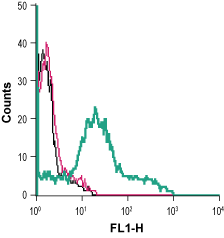Overview
- Peptide CRPIYEFHGLYEEK, corresponding to amino acid residues 270-283 of human P2X1 receptor (Accession P51575). Extracellular loop.
- Human MEG-01 megakaryoblastic leukemia cells, mouse M1 myeloid leukemia cells (5 µg antibody/0.5x106 cells).
 Cell surface detection of P2RX1 in live intact human MEG-01 megakaryoblastic leukemia cells:___ Cells.
Cell surface detection of P2RX1 in live intact human MEG-01 megakaryoblastic leukemia cells:___ Cells.
___ Cells + rabbit IgG isotype control-FITC
___ Cells + Anti-P2X1 Receptor (extracellular)-FITC Antibody (#APR-022-F), (5 µg antibody/0.5x106 cells). Cell surface detection of P2RX1 in live intact mouse M1 myeloid leukemia cells:___ Cells.
Cell surface detection of P2RX1 in live intact mouse M1 myeloid leukemia cells:___ Cells.
___ Cells + rabbit IgG isotype control-FITC
___ Cells + Anti-P2X1 Receptor (extracellular)-FITC Antibody (#APR-022-F), 5µg.
The P2X receptors belong to the ligand-gated ion channel family and are activated by extracellular ATP.
The structure and function of the P2X receptors, investigated mainly using in vitro models, indicate their involvement in synaptic communication, cell death, and differentiation.
Seven mammalian P2X receptor subtypes (P2X1–P2X7) have been identified and cloned1-3. All P2X receptor subtypes share the same structure of intracellular N- and C-termini two membrane-spanning domains and a large extracellular loop.
All P2X receptor subtypes can assemble to form homomeric or heteromeric functional channels with the exception of P2X6, which only seems to function as part of a heteromeric complex4-9.
The various P2X receptor subtypes show distinct expression patterns. P2X1-6 have been found in the central and peripheral nervous systems, while the P2X7 receptor is predominantly found in cells of the immune system4. The P2X1 receptor is present in smooth muscle, cerebellum, dorsal horn spinal neurons, and platelets where it is suggested to play a regulatory role during in vivo homeostasis and thrombosis3,4,10,11.
